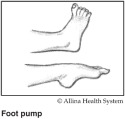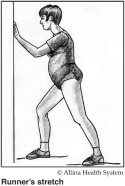
Second trimester: Discomforts
Digestive system discomforts
When you're pregnant, hormones relax and slow intestinal movement. That makes food travel through the digestive system more slowly. This allows more nutrients to be absorbed. In addition, the growing uterus crowds the intestines and stomach. As a result, you can have heartburn, indigestion and constipation.
Heartburn
When the muscle at the top of your stomach relaxes, acid can flow into your esophagus (the tube that passes food from your mouth to your stomach). This causes a burning feeling in your chest and throat. To help reduce this effect:
- Eat small meals and snacks often. Do not overeat.
- Drink liquids between meals rather than with meals.
- Sip milk, hot tea or water.
- Avoid fried or fatty foods, spicy foods, and caffeine.
- Keep a food diary to help you identify other foods that give you heartburn.
- Avoid lying down or bending over for two hours after eating.
- When you do lie down, rest on your side and prop your head and shoulders with pillows.
- Raise the head of your bed on small blocks to help prevent nighttime heartburn.
- Ask your health care provider about using an antacid.
Indigestion
To prevent the queasy and gassy feeling of indigestion, try these suggestions:
- Avoid foods that produce gas.
- Eat small, frequent meals.
- Get regular exercise.
- If you have bloating, ask your health care provider about taking medicine to reduce gas.
Constipation
To help avoid constipation:
- Drink eight to 10 glasses of liquids (at least 64 ounces) a day.
- Try a hot or warm drink first thing in the morning.
- Eat high-fiber cereals, whole grains, fruits (such as pears, mangoes, plums, prunes, beets and peaches), vegetables and legumes.
- Walk or exercise daily.
- Talk with your health care provider before you take a laxative.
Other discomforts
Varicose veins
The pressure of a larger uterus and baby, increased blood volume, and increased relaxation of blood vessels can result in varicose veins. To help reduce them:
- Avoid standing for long periods of time.
- Change positions often when you are standing or sitting. Gently shifting your weight from foot to foot keeps the blood moving.
- Don't cross your legs when you sit.
- Avoid wearing knee-high stockings that can restrict blood flow. Consider wearing compression stockings.
- Swim or walk to improve the circulation in your legs.
Hemorrhoids
Hemorrhoids are varicose veins in the rectum and anus. To reduce the chance of getting them or to cope with them:
- Eat foods high in fiber.
- Drink plenty of liquids.
- Avoid straining when you are having a bowel movement.
- Exercise regularly.
- Apply compresses of witch hazel or Tucks® for relief.
Breathlessness
You may sometimes feel breathless when you climb the stairs or exert yourself. Your body is adjusting to accommodate a growing uterus and movement of other organs in your abdominal cavity. To help your breathing:
- Take your time going up stairs.
- Carry smaller packages and grocery bags.
- Adjust your exercise routine. Go slower and cover shorter distances.
If you are having trouble getting your breath or if it is hard to breathe, call your health care provider.
Round ligament pain
A round ligament anchors your uterus on the right and left side. If you move suddenly, especially when getting up or raising your arms, you can feel a sharp tug. Overstretching these ligaments causes this pain. Moving slowly can help prevent most of this overstretching. It can also be helpful to support your abdomen when coughing, sneezing or changing positions.
Ask your health care provider about simple maternity support garments that support the round ligament if you have ongoing discomfort.
Leg cramps
Circulation changes can also cause leg cramps or "charley horses." Exercises like walking and swimming help improve circulation and can reduce cramps in your calves. In addition, you can do foot pumps and stretches.

Foot pump
If you have not had leg cramps, do a series of this exercise several times a day. You can do this exercise while sitting or lying on your side. You can exercise both legs at the same time or separately.
- Point your heel and hold for five seconds.
- Point your toe and hold for five seconds.
- Repeat the cycle five times. If you've started having leg cramps, don't point your toe.
- Point your heel and hold for five seconds.
- Release the point and return your foot to its usual position for five seconds.
- Repeat the heel point and hold.
- Repeat the cycle five times.

Runner's stretch
- Stand a little less than an arm's length from a wall.
- Step toward the wall with your right foot and keep your right knee bent. Keep your left leg straight.
- Put the palms of your hands on the wall. Bend your elbows and lean forward over the front leg.
- Keep both heels on the floor.
- Lean until you feel a gentle pull in your left calf. Hold that stretch for the count of 10.
- Switch legs.
- Stretch each leg five times.
You can also use a runner's stretch to relieve a cramp. Stretch the leg that is having the cramp. If you can't stand during the cramp, point your heel as firmly as you can. You can also have someone help you point your heel.
To reduce nighttime leg cramps:
- Keep your legs warm.
- Avoid pointing your toes when stretching your legs in bed.
- Make sure you are getting the calcium you need.
- Limit processed snack foods and soft drinks.
- Eat a diet rich in magnesium (beans, nuts, dark leafy greens, bananas).
To reduce nighttime leg cramps:
- Keep your legs warm.
- Avoid pointing your toes when stretching your legs in bed.
- Make sure you are getting the calcium you need.
- Limit processed snack food and soft drinks.